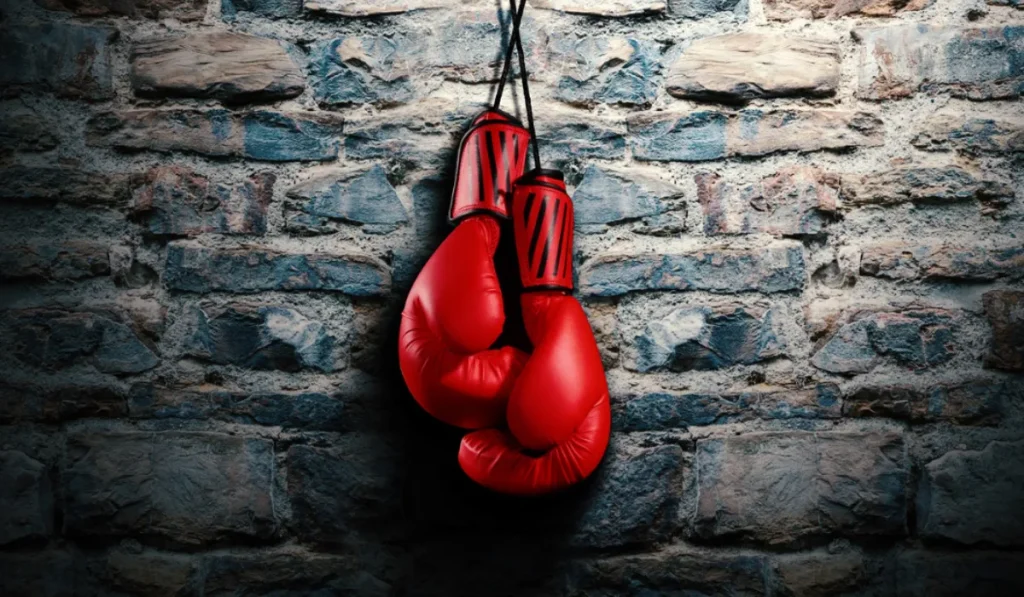Boxing gloves typically weigh between 8 to 20 ounces. Their weight varies depending on use, from training to professional fights.
Boxing gloves serve as essential gear for fighters, offering protection and enhancing performance during training or competition.
Glove weight is a crucial factor determining the intensity and safety level of a boxing session. Lighter gloves, often used in professional matches, ensure quick, precise punches.
Heavier ones, aimed at training, help in building strength and endurance while ensuring a greater degree of cushioning for safety during sparring.
Beginners and professionals alike must choose the appropriate glove weight to align with their skill level, weight class, and type of activity to avoid injury and comply with regulations.
Proper glove weight maintains the balance between offense and defense, making it a critical component in the art of boxing.

Weighing In On Boxing Gloves
Boxers, coaches, and enthusiasts always ask a critical question: How heavy are boxing gloves?
This weight affects performance, training, and competition. Now, let’s dive into the specifics and discover the true weight of boxing gloves.
Significance Of Glove Weight In Boxing
Why does glove weight matter? It’s simple. Gloves protect your hands and your opponent.
Heavier gloves mean more padding, less impact. They are crucial for safety. Now, consider these points:
- Heavier gloves reduce hand and wrist injuries.
- They ensure fair play in competitions.
- Training with heavier gloves improves strength.
Standard Weights And Variations
Boxing gloves come in different weights. From light bags to heavy sparring, weight varies. Here’s a breakdown:
| Glove Type | Weight (ounces) |
|---|---|
| Bag Gloves | 4 – 6 oz |
| Professional Fight Gloves | 8 – 10 oz |
| Training Gloves | 12 – 16 oz |
| Sparring Gloves | 16 – 20 oz |
Remember: Choose the right glove for your training. Match the glove to your weight class and the type of training you do.
Picking the correct weight ensures a safe and effective boxing experience!
The Anatomy Of Boxing Gloves

Exploring the design of boxing gloves reveals the secrets behind their weight. Each glove carries a precise blend of materials and padding.
These elements protect fighters’ hands and impact the gloves’ heaviness. Let’s dive into their structure.
Materials And Construction
Boxing gloves have layers. Outside, tough leather or synthetic leather. Inside, various materials add comfort and durability.
- Leather – Traditional choice, highly durable
- Synthetic leather – Lighter, less expensive
- Nylon threading – Holds parts together securely
A good stitching pattern ensures toughness. Gloves must withstand intense hits and friction.
Impact Of Padding On Weight
Padding decides a glove’s weight. Greater padding means more protection but also more weight.
- Foam varieties – Different densities alter weight
- Distribution – More in the knuckle area
Heavier gloves are typically 14 to 18 ounces. They suit training and sparring. Lighter ones, around 8 to 12 ounces, are for professional matches.
| Glove Type | Common Weights |
|---|---|
| Training Gloves | 14-18 ounces |
| Professional Fight Gloves | 8-12 ounces |
Weight Classes And Glove Specifications

In the world of boxing, the weight of gloves plays a crucial role. Different weight classes require different glove specifications to ensure fair competition and safety.
Understanding these specifications can help determine the right gear for training and competition.
Professional Vs. Amateur Requirements
Professional and amateur boxers follow different rules for glove weights. Here’s what you need to know:
- Professional gloves are typically lighter, favoring agility and punch speed.
- Amateur gloves often have more padding, prioritizing safety and protection.
A boxer’s weight class defines the exact glove size used in professional fights. For instance:
| Weight Class | Glove Weight |
|---|---|
| Flyweight | 8 oz |
| Welterweight | 10 oz |
| Heavyweight | 10 oz or 12 oz |
For amateurs, the glove weight is usually consistent across divisions, at 10 oz or 12 oz based on age and competition level.
Influence On Performance And Safety
The weight of boxing gloves shapes both performance and safety. Here’s how:
- Heavier gloves can reduce the risk of injury, with more padding to absorb impact.
- Lighter gloves increase punch speed, critical for professional fights.
Choosing the right glove weight is essential. It ensures a balanced fight and minimizes the risk of hand and head injuries.
Gloves that are too heavy can cause fatigue. Gloves that are too light might not offer enough protection.
It is crucial to select gloves that meet the requirements of the weight class while still fitting comfortably and providing adequate protection.
The Balancing Act: Weight Vs. Protection
The dynamic interplay of weight and protection in boxing gloves is pivotal. Optimal glove weight ensures safety and compliance with regulations.
Diverse training scenarios and competition stages demand specific glove characteristics. Understanding these nuances is essential for boxers at any level.
Finding The Optimal Glove For Training
Training gloves are integral to a boxer’s routine. They come in various weights, tailored to an individual’s size and skill level.
These weights range typically from 12 to 20 ounces. A heavier glove bolsters defense mechanisms while providing an intense workout for the arms.
For beginners, a 16-ounce glove is a standard recommendation. Progress in intensity and technique might necessitate transitions in glove weight. Choosing the correct weight is pivotal:
- Avoid injury: Too heavy can strain wrists; too light might not offer enough protection.
- Boost endurance: Extra ounces amplify arm strength over time.
- Enhance technique: Proper weight supports form maintenance under fatigue.
Competition Gloves: The Quest For Fairness
Competition gloves are lighter, promoting precision and power. They generally weigh between 8 and 10 ounces.
Uniform weight across competitors ensures fairness in each bout. Here’s a snapshot:
| Fighter Class | Glove Weight |
|---|---|
| Lightweight | 8 ounces |
| Heavyweight | 10 ounces |
In amateur fights, protection is heightened with heavier gloves, often up to 12 ounces. This nurtures upcoming talent by prioritizing safety. Key points include:
- Equal footing: Same weight gloves for all competitors.
- Safety first: Adequate padding reduces the risk of injury.
- Regulatory compliance: Gloves meet specific boxing association standards.
Debunking Myths Around Glove Weight
Step into the ring of truth as we tackle the topic of boxing glove weight. Misinformation spreads faster than a boxer’s jab, and it’s time to set the record straight.
We’ll separate fact from fiction in the world of boxing gear, particularly the weight of gloves used by professionals and amateurs alike.
Join us as we debunk myths that have long shadowed boxing circles, shedding light on the real numbers behind these essential pieces of equipment.
Common Misconceptions In Boxing Circles
Many boxers and fans alike harbor false beliefs about how much boxing gloves weigh. Let’s knock out some of these misconceptions:
- All boxing gloves are the same weight: Not true! Gloves vary in weight to match different purposes.
- Heavier means better protection: While heavier gloves have more padding, protection also relies on glove quality.
- Professional boxers use the heaviest gloves: In fact, pros often use lighter gloves to increase punch power.
Reality Behind Glove Weight Claims
The actual weight of boxing gloves is much more nuanced than myths suggest. Here’s the truth:
| Glove Purpose | Weight Range (ounces) |
|---|---|
| Bag Gloves | 4-8 |
| Training Gloves | 8-20 |
| Sparring Gloves | 14-20 |
| Professional Fight Gloves | 8-10 |
| Amateur Fight Gloves | 10-12 |
Understanding the weight ranges provided in this table offers clarity on how different glove types suit varied boxing activities.
Unlike the myths suggest, glove weight serves specific purposes, from training safety to fight regulations. Making an informed choice ensures both performance enhancement and proper hand protection.
FAQs About Boxing Glove Weight
What’s The Average Weight Of Boxing Gloves?
Boxing gloves typically weigh between 8 to 20 ounces. The weight chosen generally correlates with the boxer’s size and the type of boxing they are participating in.
Pros might use heavier gloves for training to improve their endurance.
How Do Boxing Glove Weights Affect Performance?
Heavier gloves provide more padding and protection, making them ideal for training and sparring.
Lighter gloves are used in professional fights for faster punches but offer less hand protection. Choosing the right weight impacts both safety and fighting style.
Can You Measure Boxing Glove Weight At Home?
Yes, you can weigh boxing gloves using a kitchen or luggage scale. Simply place the gloves on the scale and ensure it’s set to ounces for an accurate measurement.
Remember that gloves might vary slightly in weight due to usage and wear.
Are Heavier Gloves Better For Beginners?
Heavier gloves are recommended for beginners as they offer more padding and protection for the hands and wrists. Starting with gloves ranging from 12 to 16 ounces can help novices develop technique while minimizing the risk of injury.
Conclusion
Understanding the weight of boxing gloves is essential for every fighter. From 8 ounces for professional bouts to 16 ounces in training, the right choice can impact performance. Remember to consider your needs and regulations. Choose wisely to ensure safety and efficacy in the ring.
Now, step into the arena with confidence, gloves at the ready!
Resources:
https://www.tsa.gov/travel/security-screening/whatcanibring/items/boxing-gloves
https://dos.ny.gov/system/files/documents/2018/09/commission-bulletin-2015-2.pdf
